Looking for the best azulejos in Porto? Look no further. Here you’ll find 11 incredible displays of blue and white tiles (+ info on how to get there).
I don’t precisely know what is about Portugal that attracts me back over and over. Maybe it’s its people, open and relaxed; or maybe its old history and the culture that it’s a mix of American, African, and Asian influences.
The food is certainly a plus (I love Portuguese dessert!), and last but not least, the architecture. More precisely, the mix of old and new, of minimalist and super colorful.
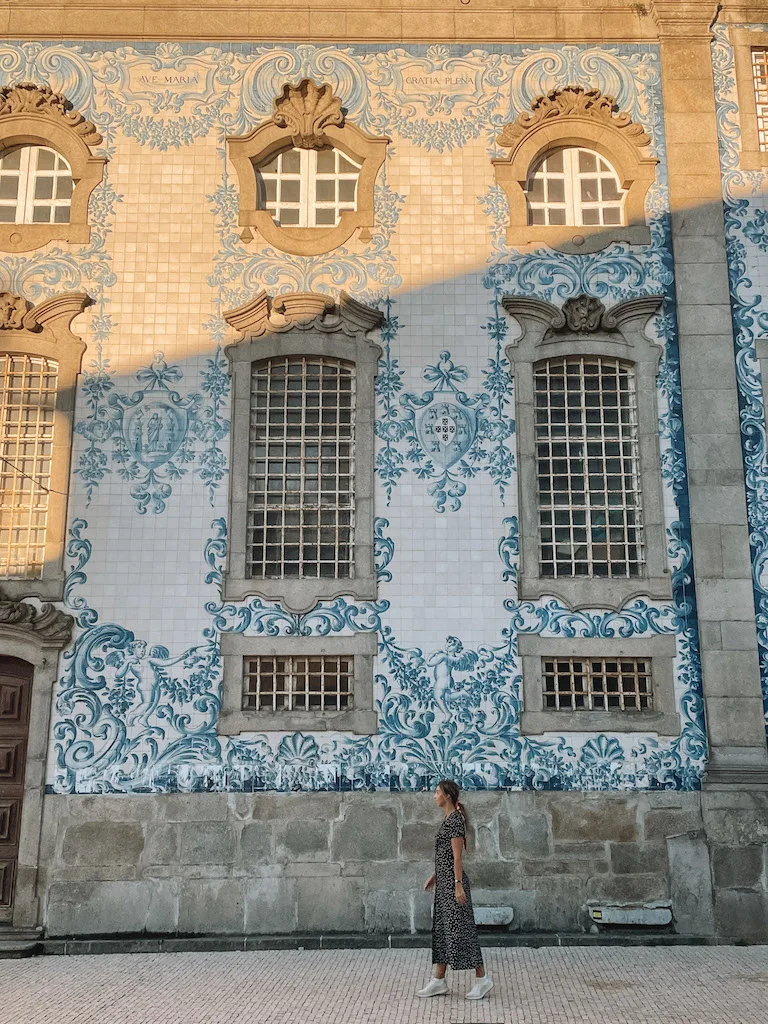
The first time I visited Porto, I immediately fell in love with its buildings covered with azulejos. Maybe you’re spending 2 or 3 days in Porto, or maybe it’s just a quick stop on a road trip through Portugal – no matter how long you’re in Porto, it’ll be easy to find a couple of azulejos examples to check out.
Today I want to give you a little guide to help you find all my favorite spots to check out these beautiful Portuguese tiles in Porto.
An Introduction to Azulejos in Porto
Azulejos, in English glazed ceramic tiles, can be found all around the cities of Portugal and are one of the most popular cultural artifacts produced in Portugal. They are indeed known all over the world because they give such a distinctive look and feel to buildings and churches. But the Portuguese tile art is not just decorative, it also tells stories about Portugal and its past.
If you have been to Portugal, especially in the major cities like Lisbon and Porto, you might have noticed the eye-catching Portuguese ceramics on the walls of train stations, buildings, churches, and public murals.
Maybe you’ll have seen that most of these tiles depict navigators and ships. More recently, though, many tile designs have been made of other topics like animals and oriental designs.
Today, there are many tile factories and stores that sell the azulejos in Porto and other Portuguese cities. Since the Portugal tiles are pretty inexpensive and widely available, they are tempting buys if you want to own a piece of this Portugal’s historical art. It’s not by chance that Portugal azulejos are a favorite souvenir!
You can easily go on a DIY tour to check out some incredible buildings decorated with azulejos, and you can even try and paint your own tiles if you’re feeling creative!
Ready to get in touch with your creative side? The Art of Azulejos Experience allows you to paint your own two tiles and bring them home (the perfect souvenir). I’ve done something similar in Barcelona and had a blast, and it’s a great option if you’re traveling with kids! ➥ BOOK IT HERE
These are the best places to check out if you are in search of the best azulejos in Porto, Portugal.
Capela das Almas

The Capela das Almas, also known as the Chapel of Souls, is famous for being literally covered in blue and white tiles. Something interesting about this chapel is that the tile work depicts scenes from the lives of saints. While the architecture of the chapel is relatively simple, the fact that it’s covered with 15,947 tiles (can you imagine the amount of work?) is what makes it stand out.
This chapel was built in the 18th century and these Portuguese wall tiles were designed by potter Eduardo Leite, made in a factory in Lisbon, and placed in 1929. It’s no surprise that this is one of the most photographed buildings in Porto.
Address: Rua de Santa Catarina
Metro: Metro Station Bolhao
São Bento Train Station

The Sao Bento Train Station in Porto is the most beautiful train station in Portugal. First opened in 1916, the tile work began five years after the station was built. And although it might look ordinary from the outside, the real beauty lies within.
It’s definitely a place you need to add to your Portugal itinerary, even more so since you’re looking for the best azulejo tiles in Porto!
The main hall features an impressive tile work that consists of 20,000 tiles telling the history of Portugal. You’ll find depicted here the Battle of Valdevez and the Conquest of Ceuta, and many other important events in history. A must-see!
Address: Praca de Almeida Garret
Metro: Line D
Se do Porto (Porto Cathedral)
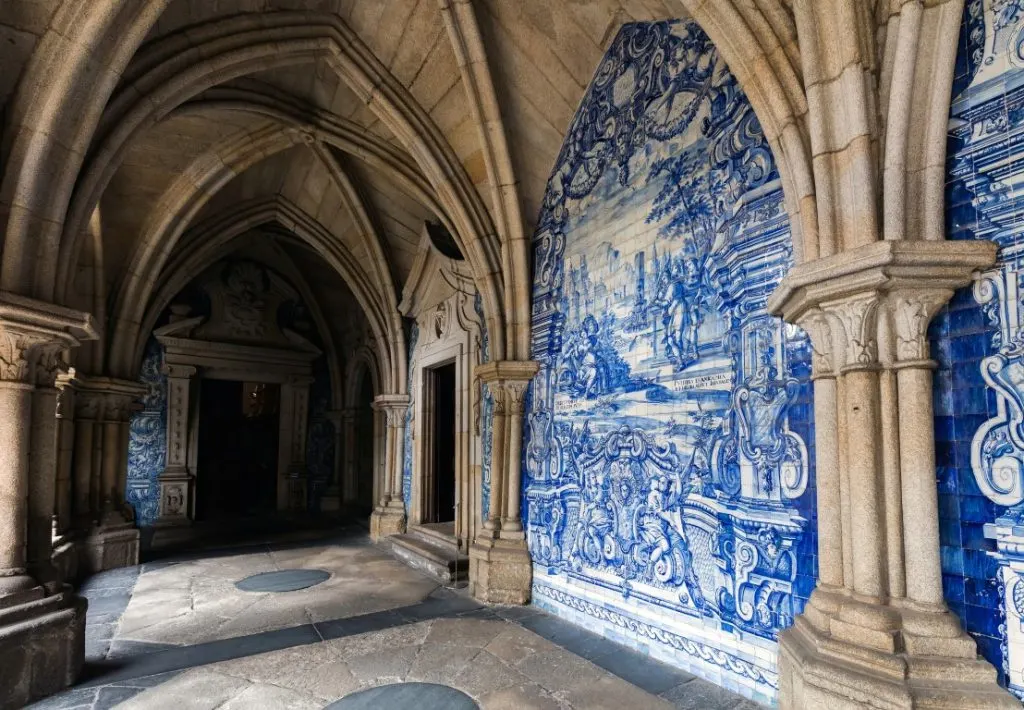
The Porto Cathedral features dark and gothic architecture, but the real beauty of the church lies in its cloister walls. In fact, it’s known as one of the best places in Porto where you can find the best azulejos. The blue and white tiles depict scenes from ‘The Metamorphosis’ along with the life of Mother Mary.
The interior of this medieval, dark cathedral provides a beautiful contrast to the very bright blue and white tiles on the cloister walls. You’ll see how they also used the beautiful Portuguese ceramics on the outside walls of the cathedral.
Address: Terreiro da Sé
Subway Train: Sao Bento Station
Igreja de Santo Ildefonso
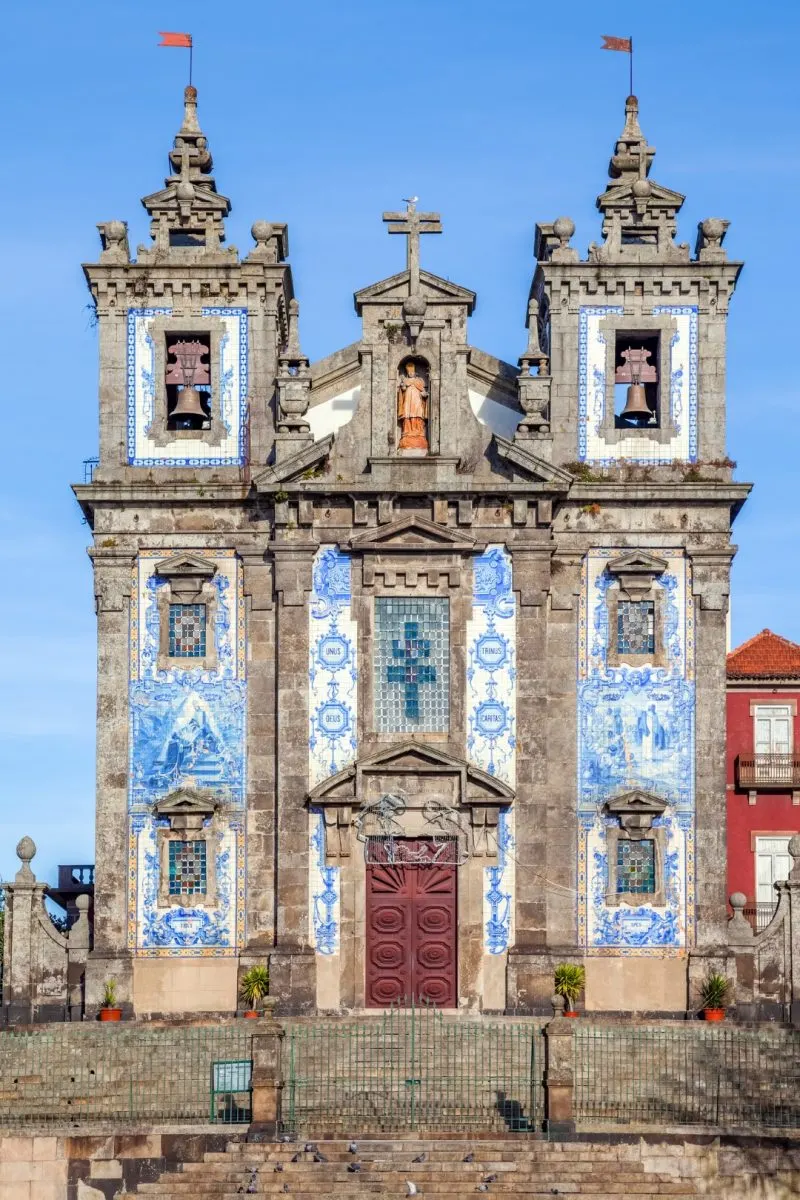
The Igreja de Santo Ildefonso or Church of Saint Ildefonso is an 18th-century church in Porto, Portugal, and personally is one of my favorites showcases of Porto tiles. It’s not surprising that the church is one of the buildings that form the “Porto historical center”, declared a UNESCO World Heritage Site in 1996 (another place on the same list is the Sao Bento Railway Station).
This church was built in 1739 and features a façade of azulejo tile work. Located in Praca de Batalha, this Baroque-style building will surely catch the eye of any passersby because of the elaborate tilework on its façade (so elaborate that they completed the tile work only in 1932!).
This is a work of Jorge Colaco, who used 11,000 tiles to cover the entire façade of the church (the same artist is also behind the tile work in Sao Bento station). The Portuguese ceramic tiles depict the life of St. Ildefonso, as well as the allegories from the Eucharist.
Address: Rua de Santo Ildefonso
Subway Train: Sao Bento Station
Igreja do Carmo
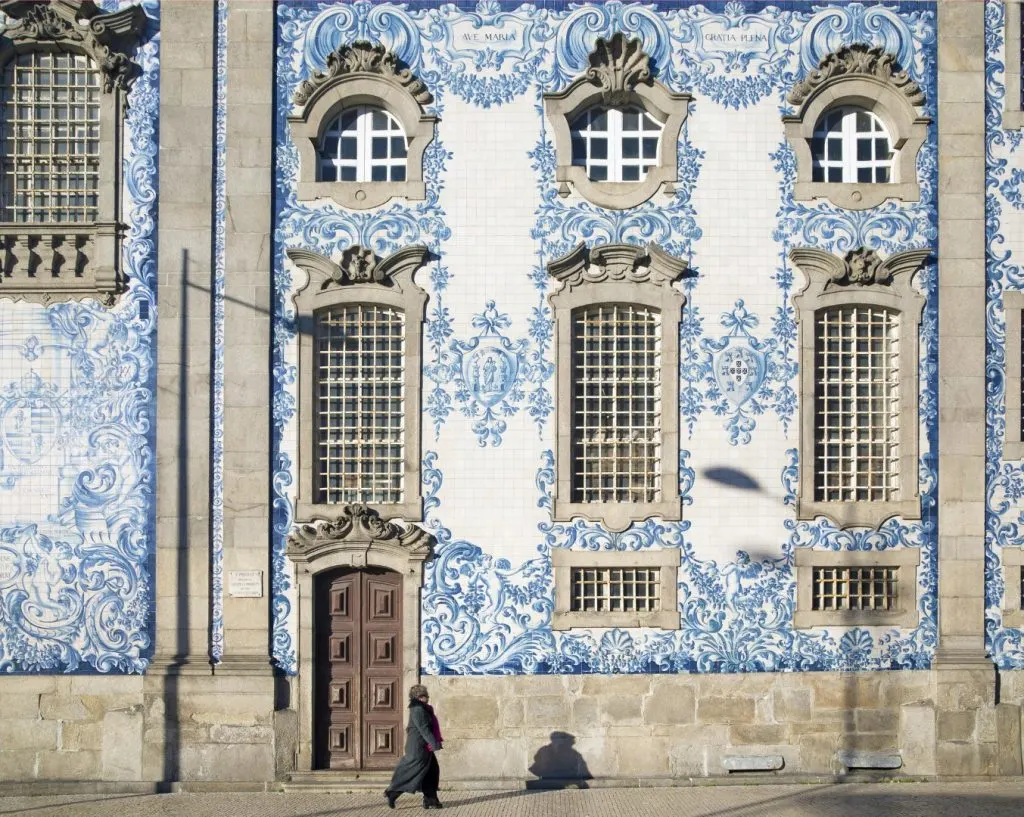
Another popular place to spot the best Porto mosaic tiles is Igreja do Carmo, one of the best examples of azulejos in Portugal. This azulejos-covered church dates back to the late 18th century and is one of the best examples of the rococo architectural style. In my opinion, this is probably the most beautiful church in Porto.
As it usually happened, the exterior of the church was completed in 1878 but the interior was completed over a century and a half prior. As for the tile work, it was completed in 1910 and it pays tribute to Nossa Senhora.
Address: Rua do Carmo
Train Station: Aliados
Casa da Musica

Casa da Musica, a music hall in Porto that was finished in 2005, is the first one that was exclusively dedicated to music – for artistic training, creation, and public performances. You’ll find here not only contemporary style architecture but also beautiful azulejos art to admire.
The VIP hall, where the amazing azulejos are placed, is covered with hand-painted white and blue tiles. It’s a stunning contrast to the high modernism of the rest of the building.
Address: Avenida da Boavista
Metro: Casa da Musica Station
Igreja dos Congregados
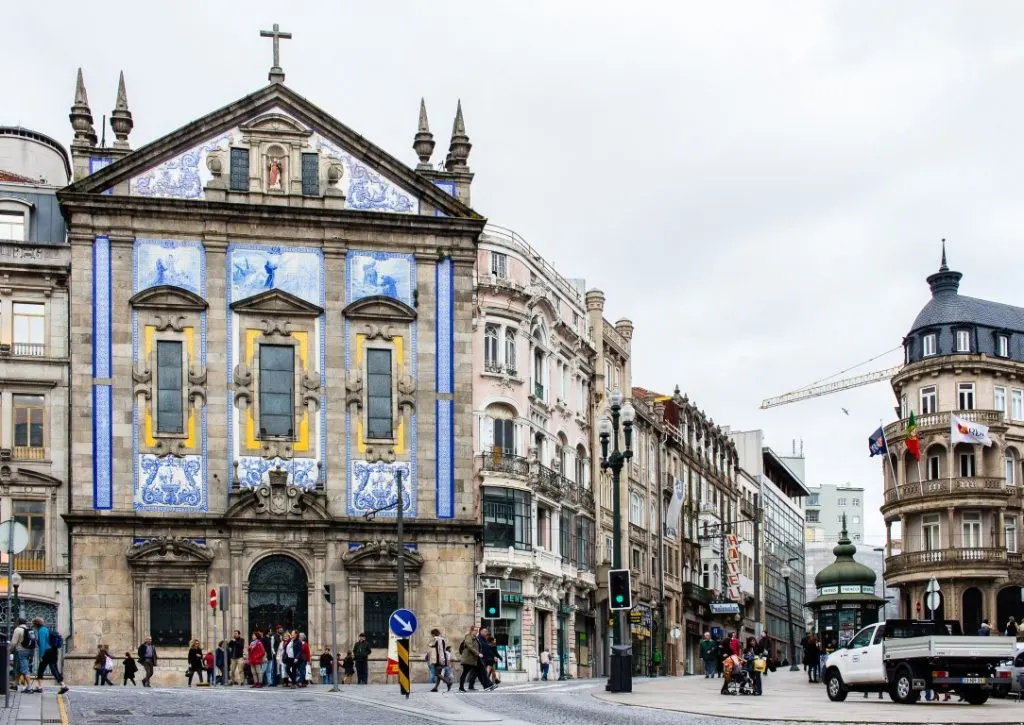
Igreja dos Congregados, also known as Igreja de Santo Antonio dos Congregados (the Church of St. Anthony’s Congregation), is another must-visit attraction if you want to see the best azulejos in Porto. Completed in 1680, this church went through many changes in history, especially as a hospital and military equipment storage during the siege from 1832 to 1835.
Today, Igreja dos Congregados is visited by tourists for its extravagant tile work. The façade is elaborately decorated with blue and white tiles, and this tile work is so stunning that it just dominates the square.
Address: Rua de Sá da Bandeira
Train Station: Sao Bento
Banco de Materiais
The Banco de Materiais, in English “Bank of Materials”, is one of the most historic places in Porto. This building was a concept proposed by the local government in 2010, and essentially the idea was to have a place to preserve and display the tiles designs. It’s a great spot for building owners to get inspiration to decorate their facades with the beautiful azulejos, and anyone can deposit or borrow tiles.
This is the best showcase of azulejos tiles – here you’ll find everything from the more simple to very elaborate azulejo patterns. In addition to these gorgeous tiles, there are other decorative pieces such as iron and decorative stones.
Address: Praça de Carlos Alberto, 71
Train Station: Aliados
Bramica

If you want to go beyond seeing the beautiful blue and white Portuguese tiles, Bramica is the best place to go. Here, you have the chance to learn how to make the azulejo tiles yourself. There are workshops held here regularly, and if you sign up for one they will provide all of the materials and equipment that you will need to create your own tiles.
Whether you want to take your tiles as souvenirs for home or you want to gift them to someone, Bramica definitely makes for an interesting experience.
Address: Rua de Santo Isidro, 181
Subway Train: Marques Station
Azul Cobalto
If you’re wondering where to buy Portuguese tiles in Porto, you need to head to Azul Cobalto. A warning though: it will be difficult to leave as you’ll be in awe of the amazing collection of traditional blue and white Portuguese tiles. You’ll definitely end up taking home some hand-painted Portuguese tiles, guaranteed.
These blue and white tiles share their space in this store with other goods such as handmade soap. Since the Azul Cobalto is quite close to Centro Comercial Bombarada (one of the best shopping destinations in Porto), it’s the perfect excuse to stop by this store, too.
Address: Rua Miguel Bombarda, 285
Subway Train: Aliados Station
BONUS: Pinhao Train Station

Want to see even more azulejos? It’s time to look further than Porto then. If you’re taking a day trip to the Douro (and you totally should), you’ll probably pass by the Pinhao train station, which features some beautiful tile work. Super instagrammable!
And there you go! Hopefully, this list will help you get azulejed out (which isn’t a real word but whatevs!) and find the best Porto azulejos. Let me know in the comments if you find other places worth inserting on this list. Happy travels!
OH WAIT! HERE’S MORE PORTO INSPIRATION…
How to Get from Lisbon to Porto (2021)
Why You Can’t Miss a Douro Valley Day Trip from Porto
One Week in Portugal Itinerary: From Lisbon to Porto
This post contains affiliate links, which means if you book something through one of my links I might get a commission, at absolutely no extra cost to you

viajarMOTO
Tuesday 20th of October 2020
Thanks for writing this wonderful blog post. It helped to plan our day in Porto and see the amazing azulejo.